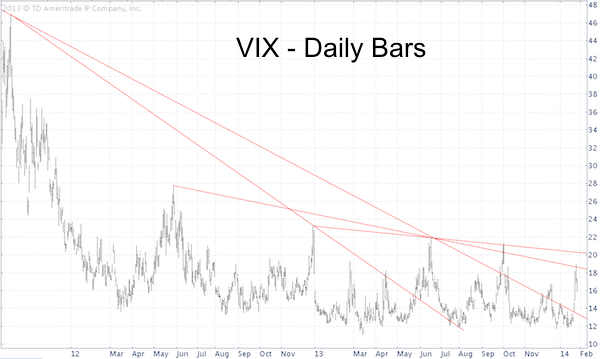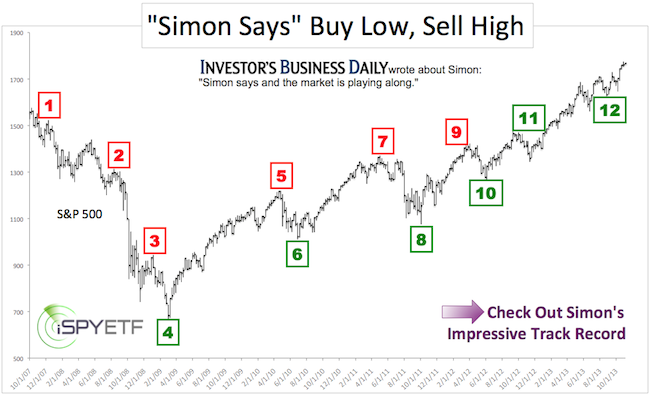Based on Bloomberg data, an unknown trader sold about $18 million in VIX (Chicago Options: ^VIX) calls on Monday.
At the time of the trade execution the VIX was trading near 19. Many of the sold calls had a strike price of 22 with February expiration.
This is a gutsy trade, but is it gutsy smart or gutsy stupid?
The seller of a February 22 VIX call commits to selling the VIX at 22 on or before the third Friday of February. Obviously, no one wants to buy the VIX at 22 as long as it trades below 22.
Therefore, the above trade will be profitable (seller gets to keep the premium) if the VIX remains below 22.
Based on the weight of evidence, this is a smart trade for the following reasons:
1. The VIX chart below (published in Sunday's Profit Radar Report) shows overhead resistance at 18.60 and 20.30.
Sunday's Profit Radar Report proposed that: "Resistance at 18.60 - 20.20 should cap the immediate VIX up side."

2. The VIX often peaks before the S&P 500 bottoms, creating a positive divergence. This means that even another minor S&P 500 (NYSEArca: SPY) low may not translate into a higher VIX high.
3. Bearish VIX strategies benefit from contango.
Contango is a condition where the VIX futures (price of VIX in the future) trade at a higher price than the VIX spot price (current price). Contango is in essence a premium. The further away the expiration of the futures, the higher the premium.
Some research on the iPath S&P 500 VIX Short-term Futures ETN (NYSEArca: VXX) suggests that the cost of contango is about 0.25% - 0.45% per day. Contango usually occurs when the VIX trades below 25.
The opposite is true as well. Contango erodes gains of bullish VIX strategies.
To illustrate: For my personal account (more or less as an experiment) I bought a March 12 VIX call, which gave me the right to buy the VIX at 12. I bought the call on January 13 for $3.20 when the VIX traded at 11.84, and sold it on January 27 when the VIX traded at 18.40.
The VIX surged 55%, but my VIX call, a highly leveraged vehicle, gained ‘only’ 40%.
The iPath S&P 500 VIX ETN (NYSEArca: VXX) gained a maximum of 20% over the same period of time, and the 2x leveraged VelocityShares Daily 2x VIX ETN (NYSEArca: TVIX) returned no more than 37%.
Keep in mind that this was an extremely well timed VIX trade. If you get the timing wrong, contango will eat into profits and emphasize losses.
The VelocityShares Daily Inverse VIX ETN (NYSEArca: XIV), an inverse VIX ETN, tends to benefit from contango when the VIX is trending lower. XIV somewhat mirrors the call selling strategy explained above.
Based on S&P 500 analysis, the VIX is in for a rocky ride ... and many profit opportunities. Here are three reasons why:
Watch for Bounce! But 3 Reasons Why a Longer Correction is Likely
If you trade or follow the VIX, you may also find this VIX seasonality chart of interest. It highlights the best two VIX trading opportunites of the year. VIX Seasonality Chart
Simon Maierhofer is the publisher of the Profit Radar Report. The Profit Radar Report presents complex market analysis (stocks, gold, silver, euro and bonds) in an easy format. Technical analysis, sentiment indicators, seasonal patterns and common sense are all wrapped up into two or more easy-to-read weekly updates. All Profit Radar Report recommendations resulted in a 59.51% net gain in 2013.
Follow Simon on Twitter @ iSPYETF or sign up for the FREE iSPYETF Newsletter to get actionable ETF trade ideas delivered for free.

|